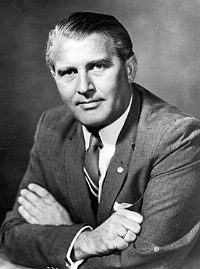
WERNHER VON BRAUN
(1912-1977)


|
WERNHER VON BRAUN(1912-1977) |
 |

Wernher von Braun was born on 23 March 1912, and died on 16 June 1977.
Received his bachelor's degree from the Berlin Institute of Technology in 1932 and two years later he received his doctorate in physics at the University of Berlin.
As a youth, von Braun dreamed of developing rockets to explore outer space. At the age of 13 he strapped six skyrocket fireworks to a red, toy wagon. The wagon traveled into the center of his home town and exploded.
In 1929, he joined the Verein für Raumschiffahrt (VfR), the German Rocket Society which had been founded on July 5, 1927. Became director of Germany's military rocket development program in 1936. Under pressure from the Third Reich, his research and development programme was driven by demands for weapons
The VfR was transferred to Peenemünde on the Baltic Coast in 1937. Here the VfR designed and built many rockets including the A4, later renamed Vengeance weapon #2 or the V-2. This was the first successful long range ballistic missile and is considered to be the ancestor of most rockets which are in operation today.
As Hitler's German war machine collapsed, Berlin ordered the VfR to destroy all classified documents. Von Braun disobeyed, hiding them in an abandoned mine. On May 2, 1945, the rocket team surrendered to invading American forces. Von Braun and his team were transferred to the US with ~150 captured V-2 rockets.
Von Braun's rocket team at Huntsville, Alabama, built the first American ballistic missile named the Redstone. In August 1953, the first Redstone rocket was tested at Cape Canaveral, Florida. On January 31, 1958, a modified Redstone (the Jupiter C), put the first American satellite, Explorer I, into orbit.
In 1960 his team was transferred to the newly established NASA to form the nucleus of the Marshall Space Center in Huntsville. Here he continued the development of larger rockets: the Saturn I, the Saturn IB (the rocket that launched the Apollo spacecraft in earth orbit) and the Saturn V: the rocket that put man on the moon.
Von Braun retired from NASA on June 10, 1972. He became involved in the private industrial sector, and was active in establishing and promoting the National Space Institute. At the peak of his activities, von Braun learned he had cancer which forced him to retire on December 31, 1976.
Von Braun is also remembered through Tom Lehrer's early 1960's song which included the line "Once the rockets go up! Who cares where they come down. That's not my department says Wernher von Braun."
Click here for more information
|
Page last updated
on 8 December 2000 . UCL
is not reponsible for the content of external sites.
|
Comments/enquiries: a.wolff@ucl.ac.uk |